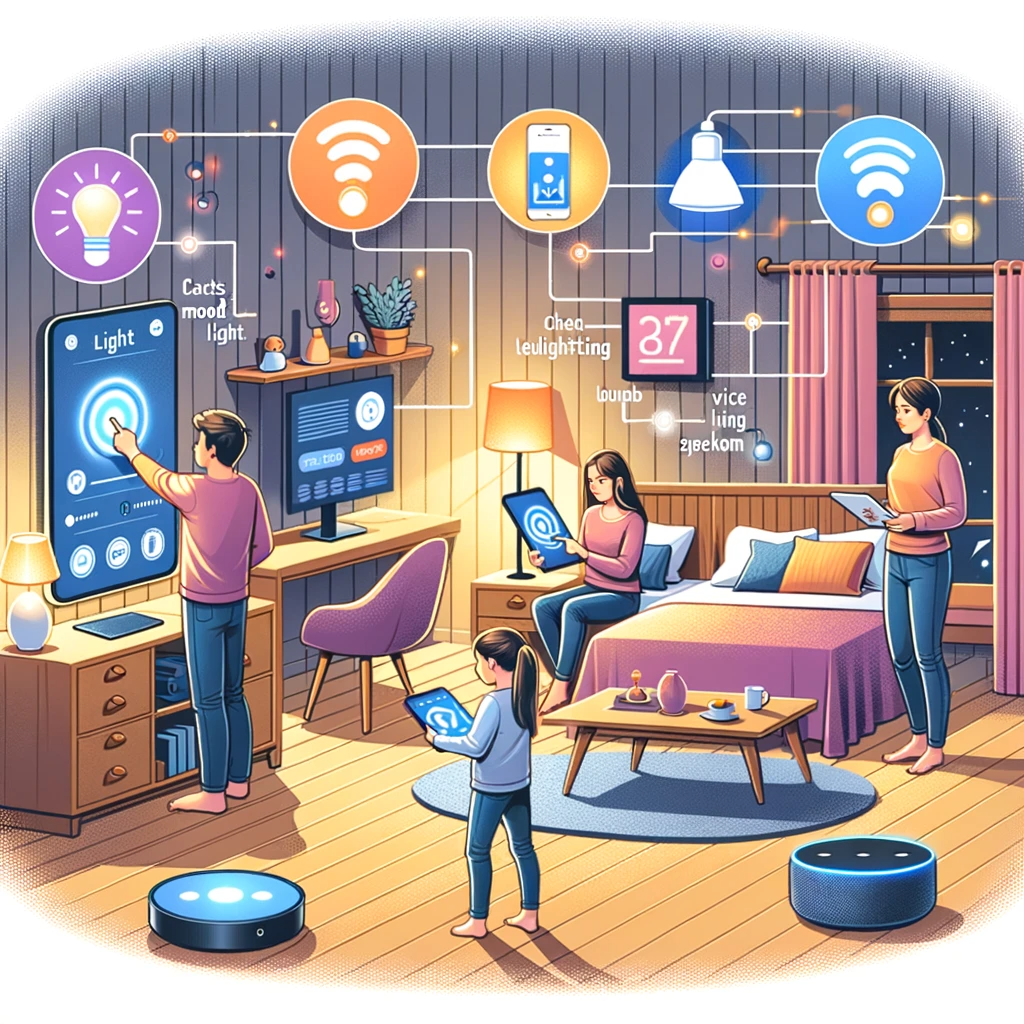Introduction to Smart Lighting Systems

Smart lighting systems are advanced lighting solutions that are designed to provide enhanced control, convenience, and energy efficiency in your home. These systems utilize technology such as wireless connectivity, sensors, and intelligent algorithms to create a more intelligent and responsive lighting environment. The purpose of smart lighting systems is to revolutionize the way we interact with and experience lighting.
Unlike traditional lighting setups, smart lighting allows you to have complete control over the brightness, color temperature, and even the scheduling of your lights. With these systems, you have the ability to customize your home’s lighting according to your preferences and needs.
Benefits of integrating smart lihgting into your home

Integrating smart lighting into your home brings numerous benefits that go beyond just illuminating a space. One major Home
advantage is the convenience it offers.
With smart lighting systems, you can control your lights using voice commands or smartphone apps from anywhere in your home. Whether you want to turn on/off specific lights or adjust their brightness levels without getting up from the couch or bed, it’s all just a simple command away.
Another significant benefit is energy efficiency. Smart bulbs often come equipped with LED technology that consumes less electricity compared to traditional incandescent bulbs.
Moreover, these systems allow you to schedule routines or use motion sensors for automatic light activation/deactivation based on occupancy. This helps reduce unnecessary energy consumption by ensuring that lights are only used when needed.
Understanding the Components of Smart Lighting Systems

Smart Bulbs: Features, Types, and Compatibility
Smart bulbs offer a range of features like color-changing capabilities, dimming options, and scheduling functionalities. These bulbs can be controlled through smartphone apps or voice commands.
They come in various types, including LED bulbs that provide energy efficiency and longer lifespan. Smart bulbs also offer compatibility with different platforms such as Amazon Alexa or Google Home, allowing seamless integration with existing smart home systems.
Smart Switches: Functionality, Installation Process, and Control Options
Smart switches enable control over traditional light fixtures by replacing standard switches with intelligent ones. They often come with touch panels or buttons for manual control but can also be operated remotely using smartphone apps or voice commands.
Installation typically involves swapping out the existing switch and connecting the smart switch to the wiring in your home. Some smart switches offer advanced features like motion sensors, timers, or occupancy detection to enhance convenience and energy efficiency.
Hub or Bridge: Importance of a Central Control Unit
Integrating multiple smart lighting devices throughout your home requires a central control unit known as a hub or bridge. This device acts as a communication hub between the smart lighting components and your smartphone or voice assistant.
The hub allows you to manage all connected devices from one centralized interface instead of controlling them individually. It ensures smooth coordination among different components and provides additional features like grouping lights together for simultaneous control in multiple areas of your home.
Choosing the Right Smart Lighting System for Your Home
Assessing your needs and preferences:
Evaluate your needs for smart lighting based on various factors such as ambiance, energy efficiency, and security. Determine the type of lighting atmosphere you want to achieve in different rooms of your home. Consider whether you prefer warm or cool tones, adjustable brightness levels, or the ability to create different scenes or moods.
Assess the energy-saving benefits of smart lighting systems that offer dimming options or motion sensors to reduce unnecessary power consumption. Additionally, think about integrating security features like scheduled lighting routines when you are away from home.
Compatibility with existing infrastructure:
Ensure that the smart lighting system you choose is compatible with your existing infrastructure, particularly regarding Wi-Fi connectivity and voice assistants integration. Check if the system requires a hub or bridge for proper functioning and if it is compatible with other devices you already have in your home network.
Verify if it supports Wi-Fi protocols that meet your network requirements and allows seamless communication between devices. Also, consider whether the system can integrate with voice assistants like Amazon Alexa or Google Assistant to enable convenient voice control functionality.
Researching available brands and models:
Conduct thorough research on available brands and models of smart lighting systems before making a decision. Compare their features such as bulb types (smart bulbs vs. smart switches), compatibility with different platforms (iOS vs. Android), ease of installation, and user-friendly interfaces offered by their respective smartphone applications.
Additionally, read customer reviews to gain insights into real-life experiences with these products – this can help identify potential issues or limitations that may not be apparent from product descriptions alone.
Consider factors like reliability, customer support services offered by manufacturers, and any additional features that may enhance your overall experience with the chosen smart lighting system. Remember to carefully assess your needs and preferences when choosing a smart lighting system, ensuring compatibility with your existing infrastructure, and conducting thorough research on available brands and models.
Installation Process and Setup Tips
Preparing your home for smart lighting installation:
Check electrical systems and wiring compatibility.
Step-by-step guide on installing smart bulbs or switches in different areas of your home:
1. Install the necessary hub or bridge for central control.
2. In the living room, choose smart bulbs compatible with dimming options and adjust color temperature to create desired ambiance.
Set up scheduling routines for automatic lighting adjustments throughout the day.
3. In the bedroom, install smart bulbs that offer warm light tones to create a relaxing atmosphere.
Take advantage of sleep-enhancing features like gradually dimming the lights before bedtime.
4. For the kitchen, customize task lighting by installing smart bulbs that provide bright illumination for cooking and food preparation tasks.
5. Outdoors, enhance security by incorporating motion sensors into your smart lighting system. Enable remote access capabilities to control outdoor lights from anywhere.
Advanced Features and Customization Options
Voice control integration with popular platforms like Amazon Alexa or Google Assistant:
Set up voice commands to turn lights on/off or adjust brightness levels effortlessly. Create scenes or moods using voice commands for added convenience.
Smartphone applications for remote access and control:
Explore smartphone apps provided by your chosen smart lighting system brand to remotely access and control your lights from anywhere with an internet connection. Enjoy features such as scheduling, scene customization, and real-time monitoring of energy consumption. Remember to refer to manufacturer manuals and guidelines during installation process for safety measures and specific instructions tailored to your chosen smart lighting system model!
Advanced Features and Customization Options
Voice control integration with popular platforms like Amazon Alexa or Google Assistant
1. You can set up voice commands to effortlessly control your smart lights.
2. Voice commands allow you to turn lights on or off and adjust brightness levels without lifting a finger.
Creating scenes or moods using voice commands
1. With smart lighting systems, you can create customized scenes or moods using just your voice.
2. By assigning specific settings to each scene, you can instantly transform the ambiance of a room.
Smartphone applications for remote access and control
1. Take advantage of smartphone applications that offer convenient remote access and control over your smart lighting system.
2. These apps allow you to manage your lights from anywhere, providing flexibility and ease of use.
Conclusion
Incorporating smart lighting systems into your home opens up a world of advanced features and customization options. With voice control integration, you can effortlessly command your lights with simple spoken instructions, making the experience even more convenient and intuitive.
Creating scenes or moods using voice commands allows you to tailor the atmosphere of each room to suit specific activities or preferences. Furthermore, smartphone applications provide remote access and control, giving you the power to manage your smart lighting system from anywhere in your home or even when you’re away.
This level of flexibility ensures that you always have complete control over your lighting environment. By embracing these advanced features and customization options, you can elevate the comfort, convenience, and ambiance of your home with smart lighting systems in an impressive way.
So why not embark on this journey toward a more intelligent and enjoyable living space? Embrace the future today!









